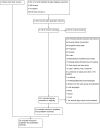A meta-analysis on the prevalence and characteristics of severe malaria in patients with Plasmodium spp. and HIV co-infection
- PMID: 34404814
- PMCID: PMC8371128
- DOI: 10.1038/s41598-021-95591-6
A meta-analysis on the prevalence and characteristics of severe malaria in patients with Plasmodium spp. and HIV co-infection
Abstract
Co-infection with malaria and human immunodeficiency virus (HIV) increases the severity and mortality rates of both diseases. A better understanding of the effects of co-infections could help in the diagnosis, prompt treatment, prevention, and control of malarial parasites among HIV-infected patients. In this systematic review and meta-analysis, we estimated the prevalence and characteristics of severe malaria (SM) caused by co-infection with HIV. We included relevant studies that were conducted between the years 1991 and 2018 and reporting on SM. We pooled the prevalence of SM in patients with co-infection, pooled odds ratios of SM in patients with co-infection and Plasmodium mono-infection, and differences in laboratory parameters such as parasite density and leucocyte counts, between co-infected and Plasmodium mono-infected patients. The meta-analysis included 29 studies (1126 SM cases). The pooled prevalence of SM in co-infected patients using the data of 23 studies (SM = 795 cases, all co-infection cases = 2534 cases) was 43.0% (95% confidence interval [CI] 31.0-56.0%; I2, 98.0%). Overall, the odds of SM from 18 studies were pooled. The odds of SM were significantly higher in co-infected patients than in Plasmodium mono-infected patients (OR 2.41; 95% CI 1.43-4.08; I2 = 85%; P = 0.001) and also significantly higher in children (OR 9.69; 95% CI 5.14-18.3; I2, 0%; P < 0.0001; two studies) than in adults (OR 2.68; 95% CI 1.52-4.73; I2, 79.0%; P = 0.0007; 12 studies). Co-infected patients with SM had a higher parasite density than those with Plasmodium mono-infection when the data of seven studies were analysed (SMD, 1.25; 95% CI 0.14-2.36; I2, 98.0%; P = 0.03) and higher leukocyte counts when the data of four studies were analysed (MD, 1570 cells/µL; 95% CI 850-2300 cells/µL; I2, 21.0%; P < 0.0001). Thus, the prevalence of SM among patients co-infected with Plasmodium spp. and HIV is high. Because co-infections could lead to SM, patients with Plasmodium spp. and HIV co-infection should be identified and treated to reduce the prevalence of SM and the number of deaths.
© 2021. The Author(s).
Conflict of interest statement
The authors declare no competing interests.
Figures









References
-
- WHO. World Malaria Report 2019 (2019). https://www.who.int/publications-detail/world-malaria-report-2019. Accessed 25 July 2020.
-
- WHO. Malaria in HIV/AIDS Patients (2017). http://www10.who.int/malaria/areas/high_risk_groups/hiv_aids_patients/en/. Accessed 25 July 2020.
-
- WHO. (2019). HIV/AIDS. Available from https://www.who.int/news-room/fact-sheets/detail/hiv-aids Accessed 31 June 2020.
Publication types
MeSH terms
LinkOut - more resources
Full Text Sources
Medical
Miscellaneous

